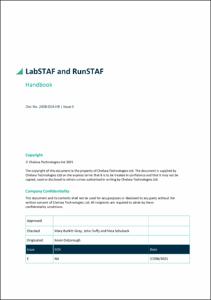Notice
This is not the latest version of this item. The latest version can be found at: https://repository.oceanbestpractices.org/handle/11329/1531.4
LabSTAF and RunSTAF Handbook 2408-014-HB Issue E.
| dc.contributor.author | Oxborough, Kevin | |
| dc.date.accessioned | 2021-08-31T11:57:13Z | |
| dc.date.available | 2021-03-25T20:26:32Z | |
| dc.date.available | 2021-07-09T21:39:28Z | |
| dc.date.available | 2021-08-31T11:57:13Z | |
| dc.date.issued | 2021 | |
| dc.identifier.citation | Oxborough, K. (2021) LabSTAF and RunSTAF Handbook: 2408-014-HB | Issue E. West Molesey, UK, Chelsea Technologies Ltd. 116pp. (Doc No. 2408-014-HB | Issue E). DOI: http://dx.doi.org/10.25607/OBP-1029.3 | en_US |
| dc.identifier.uri | https://repository.oceanbestpractices.org/handle/11329/1531.3 | |
| dc.identifier.uri | http://dx.doi.org/10.25607/OBP-1029.3 | |
| dc.description.abstract | LabSTAF is the first of a new generation of research-grade active fluorometers being developed by Chelsea Technologies Ltd (CTL) in collaboration with The University of Southampton (UoS), the National Oceanographic Centre (NOC) and The University of Essex (UoE) as part of the STAFES-APP project within the NERC-funded OCEANIDS programme (NE/P020844/1). The STAFES-APP acronym expands to Single Turnover Active Fluorometry of Enclosed Samples – for Autonomous Phytoplankton Productivity. The aim of the project is to develop highly sensitive benchtop and deployable systems that can be used to improve our understanding of the global carbon cycle and aquatic ecosystem function. Meaningful assessment of the global carbon cycle must incorporate Phytoplankton Primary Productivity (PhytoPP) which forms the base of the marine food chain and represents approximately half of the carbon fixed by photosynthesis on a planetary scale. It follows that measurement of PhytoPP on wide spatial and temporal scales has enormous potential for developing our understanding of ocean productivity and verifying climate change models. Arguably the most important way in which this target can be achieved is through the validation and development of satellite remote sensing, which operates on the widest possible spatial scales, but which currently has large errors for the estimation of PhytoPP. Most of the current methods used to measure PhytoPP directly are laboratory-based. As a consequence, these methods can only be applied on Page 8 of 116 scales that fall well short of those required. The end result is extreme undersampling of the oceanic environment for PhytoPP (e.g., Lee et al. 2015). Global assessment of PhytoPP falls within the remit of the Global Ocean Observing System (GOOS) which defines and prioritises a range of Essential Ocean Variables (EOVs). The fundamental criteria employed for defining EOVs are impact and feasibility: to make it on to the GOOS list, an EOV must have high impact and be measurable on meaningful scales using cost effective technology. Although PhytoPP clearly satisfies the impact criterion, the limitations of existing methods means it currently scores very low on the feasibility scale. PhytoPP responds to multiple, highly dynamic environmental drivers including light, temperature and nutrients. It follows that PhytoPP needs to be assessed at spatial and temporal scales that are at least as high as for existing EOVs and that new technologies and methodologies are required achieve this. Clearly, PhytoPP cannot be considered as a potential EOV while measurement scales are largely tied to land-based laboratories and the availability of research ships. In this context, autonomous platforms such as buoys, moorings, autonomous surface vehicles, gliders and Argo floats, provide opportunities to greatly increase both spatial and temporal scales for PhytoPP assessment. The challenge is to develop systems that can be deployed on these platforms and generate meaningful parameters with acceptably low errors. This challenge is central to the STAFES-APP project and LabSTAF is the first product. It is a highly portable benchtop system incorporating a range of options for both manual and highly automated operation. Although LabSTAF is limited to deployment on buoys, moorings and surface vessels, a 600 m deployable version (AutoSTAF) will be available by Late 2021. A Digital Control Unit (DCU) will be released at the same time as AutoSTAF. The deployable DCU will provide control of a Sea-Bird pump for sample exchange, provide COM-based inputs for one or two Spectral Photosynthetically Active Radiation (SPAR) sensors and either fully autonomous system control using an embedded Windows PC or remote control through an RS232 or RS422 interface. The DCU will also power the AutoSTAF unit. The DCU power input will be 9 to 36 V DC. | en_US |
| dc.language.iso | en | en_US |
| dc.publisher | Chelsea Technologies Ltd. | en_US |
| dc.relation.ispartofseries | Doc No. 2408-014-HB | Issue E; | |
| dc.subject.other | Phytoplankton | en_US |
| dc.subject.other | Primary productivity | en_US |
| dc.subject.other | Fluorometer | en_US |
| dc.title | LabSTAF and RunSTAF Handbook 2408-014-HB Issue E. | en_US |
| dc.type | Report | en_US |
| dc.description.status | Published | en_US |
| dc.format.pages | 116pp. | en_US |
| dc.contributor.corpauthor | Chelsea Technologies Ltd. (CTL) | en_US |
| dc.description.refereed | Refereed | en_US |
| dc.publisher.place | West Molesey, UK | en_US |
| dc.subject.parameterDiscipline | Phytoplankton | en_US |
| dc.subject.instrumentType | Instrument Type Vocabulary::fluorometers | en_US |
| dc.description.currentstatus | Current | en_US |
| dc.date.review | 2022 | |
| dc.description.sdg | 14.A | en_US |
| dc.description.eov | Phytoplankton biomass and diversity | en_US |
| dc.description.maturitylevel | Pilot and Demonstrated | |
| dc.description.adoption | Multi-organisational | en_US |
| dc.description.methodologyType | Method | en_US |
| dc.description.methodologyType | Specification of criteria | en_US |
| dc.description.methodologyType | Reports with methodological relevance | en_US |
| obps.contact.contactname | Kevin Oxborough | |
| obps.contact.contactemail | koxborough@chelsea.co.uk |
 Repository of community practices in Ocean Research, Applications and Data/Information Management
Repository of community practices in Ocean Research, Applications and Data/Information Management
